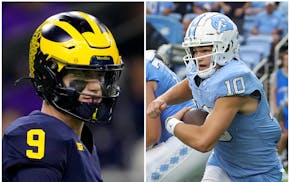The fax machines inside the Gophers football office will begin spitting out signed scholarship papers before breakfast Wednesday as recruits from at least a dozen states officially join the 2013 class. That list reportedly will include only one Minnesotan, barring any last-minute changes.
That's right, ONE, which must be some sort of record, if the school tracked such a thing.
As a state, Minnesota isn't exactly a gold mine for prep football talent, but only six in-state recruits received scholarship offers from schools in BCS conferences this year. Gophers coach Jerry Kill submitted offers to four of those players and landed one -- Wayzata linebacker Chris Wipson.
As usual, national recruiting analysts rank the Gophers' class at or near the bottom of the Big Ten, but it's hard to pin that all on Kill's ability as a recruiter. Those recruiting rankings can be arbitrary, especially after the top 25 teams.
One thing is certain, though. The Gophers will struggle to win at a high level -- or do so consistently -- unless or until high school football in this state starts producing more legitimate Division I talent.
The scarcity of in-state talent forces the Gophers to find the majority of their recruits in someone else's backyard, and it's difficult to win those turf battles for prospects who have similar or slightly better options closer to home.
The Gophers landing only one in-state recruit is so unique that it probably should be viewed as an outlier case. But even in a banner year, the state produces eight to 10 BCS-caliber prospects with the Gophers usually signing between five to seven of those. If a typical recruiting class has 25 members, that means the Gophers must sign around 75 percent of their recruits from other states.
That mathematical equation needs more balance because recruiting outside one's own borders involves a variety of factors and obstacles that complicate matters. It's just common sense that it's easier for the Gophers to sign a recruit from Minnesota than it is someone from Florida, Texas, Ohio or California.
Recruiting nationally often requires the Gophers to take more risks -- either academically or athletically -- or target recruits who aren't necessarily flooded with offers from major programs. The Gophers thought they pulled off a recruiting coup when they received a verbal commitment from Alabama athlete Nate Andrews. But then Tennessee and Florida State offered scholarships late, and anyone who has followed the Gophers program closely knew where that situation was headed. Andrews switched his commitment to Florida State. The Gophers aren't going to beat programs of that stature in too many recruiting battles in their area of the country.
It's not that our state doesn't produce elite recruits, just not enough. And it becomes a double whammy when those blue-chip players sign elsewhere. If Ohio State or Florida loses a few top in-state players, it might be viewed as a disappointment or annoyance. At Minnesota, it becomes a crisis because the talent pool is so shallow.
Population is one reason. According to Minnesota State High School League data, 25,868 kids played football in Minnesota in 2011. In Texas, nearly 170,000 kids participated, followed by California (105,000), Ohio (46,000) and Florida (41,000). Border rivals Wisconsin and Iowa encounter similar issues as Minnesota in terms of their talent depth, but they've managed to mitigate that because of the proximity to Chicago. And they've plucked talent from Minnesota, a source of consternation among Gophers fans.
Football is treated differently in other places, too. Many southern states allow high school teams to conduct spring practices, which gives those athletes more time to focus on their skill and athletic development. States in the Big Ten region don't allow spring football.
The Gophers also have suffered from the sad decline of the Minneapolis City Conference, which once offered a pipeline of talent to Dinkytown. But only three City Conference players have received scholarships from the Gophers since 1999.
That number could increase next year with the addition of Washburn running back Jeff Jones, a highly regarded prospect who recently committed to the Gophers. That's an encouraging start to 2014, but the Gophers need more help from their homegrown talent and they must close off their borders.
One in-state recruit is not nearly enough.
Chip Scoggins • ascoggins@startribune.com
Scoggins: Why 'championship or bust' fits these Wolves

Scoggins: Anatomy of a game-saving play as Correa throws out Ohtani

Scoggins: McCarthy or Maye? Ex-U coach breaks down Vikings' options
Scoggins: Cory Provus getting ready for 'biggest challenge' of career


